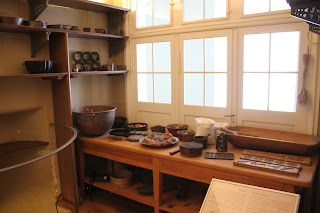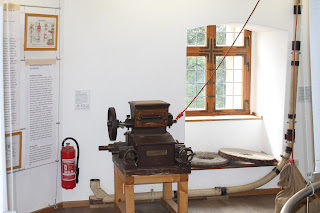Nun haben wir das Mehl gemahlen, also auf damit zur Küche und Brot und Kuchen Backen lassen. Die königliche Küche ist eine Erfindung der Neuzeit, so ca 1840, wurde der linke Flügel des Sommerschlosses zur Küche und zum Weinkeller umgebaut. Früher waren die Küchen meist weit vom Haupthaus entfernt, den gekocht wurde über offenem Feuer und die Brandgefahr war groß und die erste Feuerwehr wurde 1862 gegründet. Aber damit das Essen nicht kalt bei Tisch ankommt, kommt es jetzt von nebenan. Ein großer Saal mit vier langen Holztischen vor denen im Fliesenboden Holzdielen eingelassen waren, bequemeres Stehen für Füße und Rücken. Es gab zwei große Herdstellen und einen Drehspiess für den Ochsen, der später ausgebaut wurde, einen Ofen zum Brotbacken und alles ist unterkellert, hier Lagern die geistigen Getränke, bewacht vom Mundschenk.
Die Küche bleibt nunmehr kalt, ist aber ein anschauliches Lehrstück über Essenszubereitung in der Pre-Ceranfeld-Kühlschrank-Mikrowellen Zeit.
Now the flour is milled, so let's go to the kitchen, to bake bread and cake out of it.
The royal kitchen was inventier in modern times, around 1840, the left wing of the Summer Palace was made into a kitchen and a wine cellar. In former times the kitchen was always a bit far from the main building, because they cooked over Open Fire and the danger of fire hazard was High and the firefighter brigade was founded 1862. But for the sake of warm food is must come from not that far from the table. It is a big hall with four large wooden tables and in front of them in the in the tiled flour are floorboards varnished, more Comorra while working for the feet and the back. Two large fireplaces are there and a spit for an ox, wich was removed later, an oven for baking bread and the whole hall has an underground level for the Spirit of wine, botteled, stored and guarded by the cupbearer.
Nowadays there is no cooking anymore there but it's a fine example for kitchen work in the Pre ceramic stove-fridge-microwave period.
Montag, 10. September 2012
Freitag, 7. September 2012
Der Müller von Sanssouci - The Miller of Sanssouci
Bereits Friedrich Wilhelm I., der Soldatenkönig gäbe den Auftrag zum Bau einer Windmühle. So entstand 1736-38 eine Bockwindmühle, die auf dem Bock in Windrichtung gedreht wurde. Als diese baufällig wurde, gab Friedrich II. seinem Architekt Cornelius van der Bosch Auftrag und Geld eine neue Mühle zu bauen, denn die Mühle von Potsdam war durch eine Legende über die Landesgrenzen hinaus berühmt (www.Potsdam-wiki.de/index.php/Der_Mueller_von_Sanssouci).
Somit entstand eine Galeriewindmühle nach holländischem Vorbild, die später auch Teil einer von Friedrich Wilhelm IV. geplanten Prachtstraße sein sollte. Die Märzrevolution und ein Mangel an finanziellen Mitteln verhinderte die Ausführung dieses Bauvorhabens.
Die wechselvolle Geschichte der historischen Mühle von Sanssouci fand ein vorläufiges Ende mit ihrer Zerstörung in der letzten Kriegstagen im April 1945.
Von der Mühle blieb nur der Rumpf erhalten und im Jahr 1983 begann der Wiederaufbau, der sich mit Unterbrechungen bis 1995 hinzog. Seitdem wird die Mühle wieder betrieben und der freundliche Müller ist gern bereit Fragen zu seiner Arbeit und der Funktionsweise seines Arbeitsplatzes zu beantworten. Und natürlich kann man auch das Mehl, das hier gemahlen wird und das Brot, das daraus gebacken wird erwerben.
Already King Friedrich Wilhelm I, The Soldier King commisioned the building of a wind mill. And so a post mill was erected in 1736-38, wich was turned on it's post in the direction the wind from. When this one went old and ruined, Friedrich II. told his architect Cornelius van der Bosch to Build a new one with the king's own money, because the wind mill of Sanssouci was famous, even abroad (en.wikipedia.org/wiki/Historic_mill_of_Sanssouci).
So was build a gallery wind mill like the mills in Holland. Later it should be part of an avenue, but the March Revolution and the lack of money made that those plans could not come true.
The historie of the Mill of Sanssouci came to a temporary end in the last days of World War II in April 1945, when it was destroyed.
Only the stone base left from the mill and in 1983 the reconstruction began and came to an end in 1995 and since that time the mill is working again. The friendly miller is always ready to answer questions about his work and the way the mill works.
And of course one can get flour wich was grinded there or bread baked of the flour.
Somit entstand eine Galeriewindmühle nach holländischem Vorbild, die später auch Teil einer von Friedrich Wilhelm IV. geplanten Prachtstraße sein sollte. Die Märzrevolution und ein Mangel an finanziellen Mitteln verhinderte die Ausführung dieses Bauvorhabens.
Die wechselvolle Geschichte der historischen Mühle von Sanssouci fand ein vorläufiges Ende mit ihrer Zerstörung in der letzten Kriegstagen im April 1945.
Von der Mühle blieb nur der Rumpf erhalten und im Jahr 1983 begann der Wiederaufbau, der sich mit Unterbrechungen bis 1995 hinzog. Seitdem wird die Mühle wieder betrieben und der freundliche Müller ist gern bereit Fragen zu seiner Arbeit und der Funktionsweise seines Arbeitsplatzes zu beantworten. Und natürlich kann man auch das Mehl, das hier gemahlen wird und das Brot, das daraus gebacken wird erwerben.
Already King Friedrich Wilhelm I, The Soldier King commisioned the building of a wind mill. And so a post mill was erected in 1736-38, wich was turned on it's post in the direction the wind from. When this one went old and ruined, Friedrich II. told his architect Cornelius van der Bosch to Build a new one with the king's own money, because the wind mill of Sanssouci was famous, even abroad (en.wikipedia.org/wiki/Historic_mill_of_Sanssouci).
So was build a gallery wind mill like the mills in Holland. Later it should be part of an avenue, but the March Revolution and the lack of money made that those plans could not come true.
The historie of the Mill of Sanssouci came to a temporary end in the last days of World War II in April 1945, when it was destroyed.
Only the stone base left from the mill and in 1983 the reconstruction began and came to an end in 1995 and since that time the mill is working again. The friendly miller is always ready to answer questions about his work and the way the mill works.
And of course one can get flour wich was grinded there or bread baked of the flour.
Montag, 3. September 2012
Orangerie - Orangery Palace
Das Orangerie-Schloß in Sanssouci ist ein interessanter Mehrzweckbau, Winterquartier für tropische Gehölze und Sommerresidenz für König Friedrich Wilhelm IV.und seine Frau Elisabeth. Zwei getrennte Wohnungen, bestehend aus Salon - zum Angeben, Arbeitszimmer - zum Arbeiten und Schlafzimmer - zum Schlafen für Ihn, und Salon - zum Zeigen, was man hat und Schlaf-Wohn-Arbeitszimmer - zum Schlafen, Wohnen und Arbeiten für Sie. Verbunden sind beide Wohneinheiten durch eine Terrasse und getrennt durch einen großen Saal, der eine Gemäldesammlung mit Kopien von Rafael-Gemälden aufgenommen hat und schon damals der Öffentlichkeit zugänglich war.
Und wenn man schlussendlich dem König aufs Dach steigt, hat man einen grandiosen Ausblick auf den gesamten Park.
The Orangery Palace is an interesting multi purpose building, winter habitat for tropical plants and summer palace for the Prussian King Friedrich Wilhelm IV and his wife Elisabeth. Two separeted apartments, consisting of parlour for show of, a study for working and a sleeping room for sleeping for Him, and parlour for showing what we got and sleep-living-study room for sleeping, living and working for Her. Conected by a large terrace and separeted by a big hall, used as a picture gallery for copies of paintings from Rafael, wich was also shown to the public.
And when one finally climb the king on the roof, is there a gorgeous view at the whole park area.
Und wenn man schlussendlich dem König aufs Dach steigt, hat man einen grandiosen Ausblick auf den gesamten Park.
And when one finally climb the king on the roof, is there a gorgeous view at the whole park area.
Abonnieren
Posts (Atom)



























































